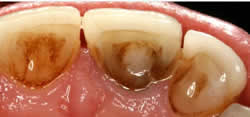Root Canal Information
 On your initial appointment the dentist will locate the offending tooth
and take an x-ray in order to show the roots of the tooth, to see how
far the decay has travelled and if there is an abscess present. A course
of antibiotics may be given to clear the abscess before the treatment
is started as the abscess will reoccur if the treatment is NOT carried
out.
On your initial appointment the dentist will locate the offending tooth
and take an x-ray in order to show the roots of the tooth, to see how
far the decay has travelled and if there is an abscess present. A course
of antibiotics may be given to clear the abscess before the treatment
is started as the abscess will reoccur if the treatment is NOT carried
out.
The first appointment
- The dentist will give you a local anaesthetic to numb the tooth and the area surrounding it.
- Your tooth will then be isolated from the rest of your teeth using a ‘rubber dam’ which is a thin sheet of rubber placed over your mouth. It is used to keep the tooth dry as saliva has bacteria present which can infect the tooth. It is also used to protect your airway as the instruments used to clean the canals are very small.
- Your dentist has to gain access to the pulp chambers, this is done by drilling a hole in the top of your tooth.
- Once access has been gained to the pulp chambers the dead pulp is removed from the root canals using very small files and a hydrochloric wash. An additional x-ray will be taken at this point.
- Once the root canals are cleaned the dentist will place a medication to help clear any bacteria. The tooth will then either be temporarily filled and another appointment required or if the infection was not too serious, the tooth can be filled permanently and your treatment complete.
- The tooth may feel tender for a few days and you may need to take pain killers
If a second appointment is necessary
- You will be given a local anaesthetic to numb tooth and the surrounding tissue
- The rubber dam will be placed and your temporary filling will be removed.
- The dentist will continue cleaning out the canals using the same process as before. Once the canals are clean and dry they will be filled with a material called ‘Gutta Percha’ which is placed into the root canal until it is sealed.
- An X-ray is then taken to check that the canals have been filled completely.
- A permanent filling will then be put in place.
- Your dentist may advise you to have a crown placed on the tooth to strengthen it.
"Any surgical or invasive procedure carries risks. Before proceeding, you should seek a second opinion from an appropriately qualified health practitioner."
